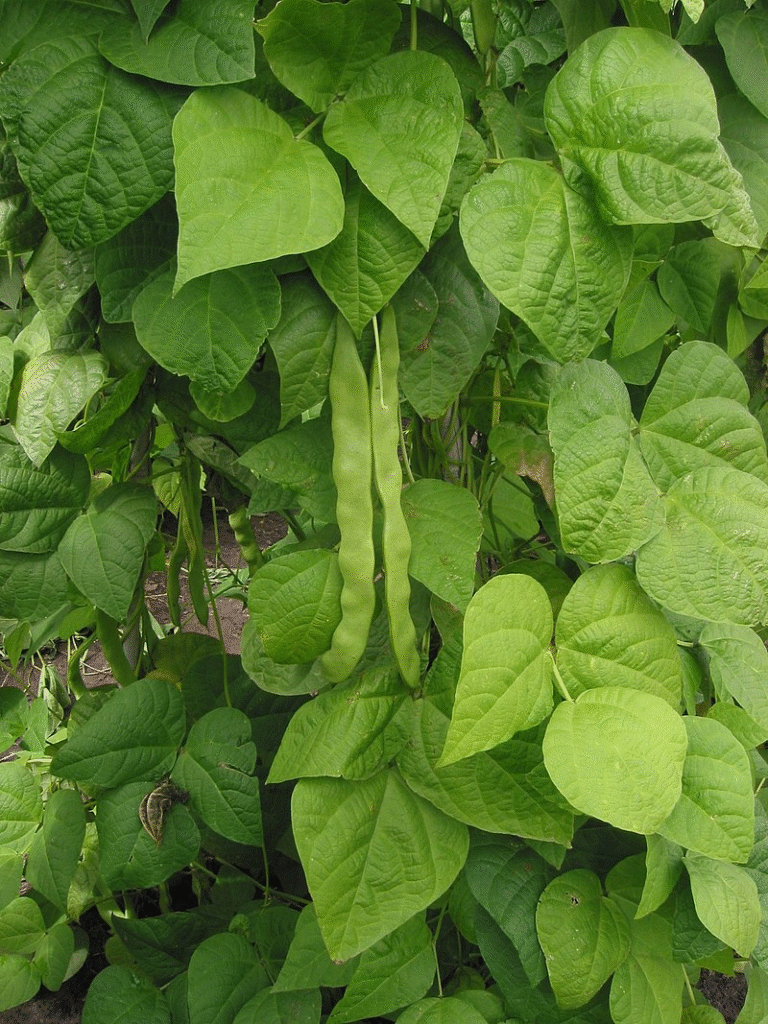Common bean
Species of beans (genus Phaseolus)
Food, Plant source foods, Flowering plats (angiospermae), Mesangiosperms, Eudicots, Core eudicots, Superrosids, Rosids, Fabids (Eurosids I), Fabales, Fabaceae (Leguminosae), Faboideae, Beans (genus Phaseolus)
Species name: Phaseolus vulgaris
Consumption area(s): No precise data were found on the spread of the common bean, but it is generally assumed to be consumed mainly in Central and South America, as well as in Central and Southern Europe.

Introduction
Common bean (Phaseolus vulgaris) is an annual herbaceous plant cultivated globally for its edible dry seeds and fresh, immature pods. Occasionally, its leaves are also consumed as a vegetable. Taxonomically, it belongs to the Fabaceae family, alongside other species within the Phaseolus genus. Like many legumes, the common bean obtains essential nitrogen through a symbiotic relationship with rhizobia, bacteria that fix atmospheric nitrogen.
Description of the plant
Bush varieties of common beans grow as upright bushes measuring between 20 and 60 centimeters (8–20 inches) tall, whereas climbing types develop long vines reaching about 2 to 3 meters (7–10 feet) in length. The leaves, which appear alternately along the stem, are usually green or purple and are made up of three smooth-edged, oval-shaped leaflets ranging from 6 to 15 centimeters (2.4–6 inches) long and 3 to 11 centimeters (1.2–4.3 inches) wide.
The plant produces flowers roughly 1 centimeter (0.4 inches) long that come in shades of white, pink, or purple and contain 10 stamens. These flowers are self-pollinating, a feature that simplifies breeding and helps maintain stable cultivars. After flowering, pods develop that measure 8 to 20 centimeters (3.1–7.9 inches) in length and 1 to 1.5 centimeters (0.4–0.6 inches) in width. Pod colors vary among green, yellow, black, or purple, each containing between 4 and 8 seeds (beans).
Description of the edible parts (seeds and pots)
The edible seeds inside the pods (also called beans or common beans) inside are smooth, plump, and kidney-shaped, growing up to 1.5 centimeters (0.6 inches) long. They exhibit a wide range of colors and often have patterns combining two or more hues. Remarkably, these seeds can remain viable for germination for up to five years. It’s important to highlight that raw or insufficiently cooked beans contain a toxic protein called phytohaemagglutinin, which can be harmful if ingested without proper preparation.
History of common bean as food
The history of the common bean traces back to the Americas, where it is believed to have been first cultivated around 8,000 years ago. Initially, it was thought to have been domesticated separately in both Mesoamerica and the Andes, but recent genetic studies indicate a single origin in Mexico, followed by its spread into two distinct genetic groups. The common bean played a key role in the Columbian exchange, reaching Europe and quickly becoming widespread in agricultural practices.
Uses of the seeds and pods of common bean
Dried bean seeds, when kept in a cool and dry environment, can stay edible for long periods without spoiling. However, over time their flavor weakens, nutritional value declines, and cooking times increase. Usually, dried beans are cooked by boiling, often after a soaking period of several hours. Although soaking is not absolutely necessary, it enables faster and more even cooking and helps remove some sugars that can cause digestive issues.

There are two main soaking techniques: overnight soaking, where beans soak in water for several hours, and a quick soak, which involves boiling the beans briefly followed by a resting period. In both cases, the soaking water is discarded before the final cooking, which typically lasts from one to four hours but can be much shorter when using a pressure cooker.
Preparation methods vary by culinary tradition. In Mexico, Central, and South America, the herb epazote is often added to improve digestion. In East Asia, kombu, a seaweed with similar properties, is commonly used. During cooking, ingredients like salt, sugar, and acidic foods such as tomato can affect the beans’ texture, slowing their cooking.
Cooked beans are also available in canned form, sometimes as refried beans or preserved in water with added salt and sugar. Apart from dried beans, there are green beans (or string beans) eaten fresh, including the pod. Common varieties include string beans with round or flat pods, and stringless beans, which lack the tough fiber along the pod. Another variety is wax beans, recognizable by their yellow or white pods. Green beans are harvested when the pods are still tender, fleshy, and shiny, with undeveloped seeds inside. They can be cooked in many ways: steamed, boiled, sautéed, or baked au gratin.
Classification of common bean
Common beans are classified according to their cultivars (the names below typically referring to the seed rather than the whole plant):
Nutritional facts table of the fruit
Since nutritional values can vary slightly depending on the cultivar, the figures provided below represent general averages.
| Nutrients | Dry beans (100 g) | Green beans (100 g) | Canned beans (100 g) |
| Calories (kcal) | 325 | 31 | 106 |
| Total fat (g) | 1.6 | 0.32 | 0.4 |
| —-Saturated fat (g) | 0 | 0 | 0.1 |
| Cholesterol (mg) | 0 | 0 | 0 |
| Sodium (mg) | 5.2 | 2 | 392 |
| Total carbohydrates (g) | 45.5 | 7.13 | 15 |
| —-Dietary fiber (g) | 17.5 | 3.4 | 6.4 |
| —-Total sugar (g) | 2.9 | 2.4 | 0.9 |
| Protein (g) | 23.4 | 1.82 | 7.8 |
Photo(s):
1. Rasbak, CC BY-SA 3.0 http://creativecommons.org/licenses/by-sa/3.0/, via Wikimedia Commons
2. Sanjay Acharya, CC BY-SA 4.0 https://creativecommons.org/licenses/by-sa/4.0, via Wikimedia Commons
